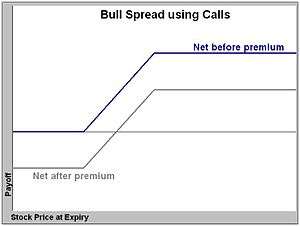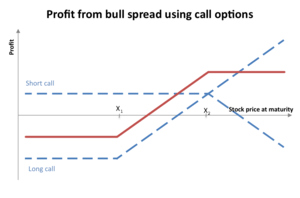Bull spread
In options trading, a bull spread is a bullish, vertical spread options strategy that is designed to profit from a moderate rise in the price of the underlying security.
Because of put-call parity, a bull spread can be constructed using either put options or call options. If constructed using calls, it is a bull call spread. If constructed using puts, it is a bull put spread.
Bull call spread
A bull call spread is constructed by buying a call option with a low strike price (K), and selling another call option with a higher strike price.


Often the call with the lower exercise price will be at-the-money while the call with the higher exercise price is out-of-the-money. Both calls must have the same underlying security and expiration month. If the bull call spread is done so that both the sold and bought calls expire on the same day, it is a vertical debit call spread.
Break even point= Lower strike price+ Net premium paid
Bull put spread
A bull put spread is constructed by selling higher striking in-the-money put options and buying the same number of lower striking out-of-the-money put options on the same underlying security with the same expiration date. The options trader employing this strategy hopes that the price of the underlying security goes up far enough such that the written put options expire worthless.
If the bull put spread is done so that both the sold and bought put expire on the same day, it is a vertical credit put spread.
Break even point=upper strike price- Net premium paid
References
- McMillan, Lawrence G. (2002). Options as a Strategic Investment (4th ed.). New York : New York Institute of Finance. ISBN 0-7352-0197-8.
The bull put spread is explained as selling ITM put and buying OTM put, while in the example both puts are ITM.